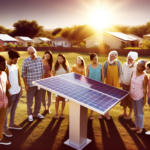Introduction to Solar Energy Storage
The Importance of Solar Energy
Solar energy has emerged as a pivotal player in the global shift towards renewable energy sources. Harnessing the power of the sun, solar energy offers a clean, sustainable, and virtually inexhaustible source of electricity. Unlike fossil fuels, solar power does not produce harmful emissions, making it an environmentally friendly alternative. The adoption of solar energy has been accelerating, driven by technological advancements, decreasing costs, and increasing awareness of environmental issues.
Solar energy is not only beneficial for reducing carbon footprints but also for enhancing energy security. By diversifying the energy mix and reducing dependence on imported fuels, countries can achieve greater energy independence. Moreover, solar power can be deployed in various settings, from large-scale solar farms to small residential installations, making it a versatile solution for different energy needs.
Why Storage is Crucial
While solar energy is abundant and sustainable, it is inherently intermittent. The sun does not shine at night, and its intensity can vary due to weather conditions. This intermittency poses a significant challenge for the reliability of solar power. Without a means to store the energy generated during sunny periods, there would be gaps in electricity supply, especially during nighttime or cloudy days.
This is where solar energy storage comes into play. By storing excess energy produced during peak sunlight hours, storage systems ensure a continuous and reliable power supply. Solar batteries, for instance, can store the surplus energy and release it when needed, effectively bridging the gap between energy production and consumption. This capability is particularly crucial during power outages or natural disasters, where a reliable energy source can be a lifeline.
Overview of the Article
This article delves into the critical role of solar energy storage in maintaining a reliable power supply, especially during emergencies and disasters. We will explore the following key areas:
1. **Understanding Solar Energy Storage Systems**: This section will break down the components of a solar energy storage system, the different types of solar batteries available, and the fundamental principles of how these systems work.
2. **Benefits of Solar Energy Storage**: Here, we will discuss the various advantages of solar energy storage, including energy independence, environmental impact, cost savings, and reliability during power outages.
3. **Solar Energy Storage in Disaster Scenarios**: This section will highlight the importance of solar storage during natural disasters, supported by case studies and practical tips for emergency preparedness.
4. **Choosing the Right Solar Energy Storage System**: We will provide guidance on the factors to consider when selecting a solar storage system, compare different systems, and cover aspects of installation and maintenance.
5. **Future Trends in Solar Energy Storage**: This section will look at the technological advancements, policy incentives, and market growth predictions that are shaping the future of solar energy storage.
6. **Conclusion**: Finally, we will recap the key points discussed, offer final thoughts on the importance of solar energy storage, and encourage readers to consider adopting solar solutions.
By the end of this article, you will have a comprehensive understanding of how solar energy storage works, its benefits, and its critical role in ensuring a reliable power supply during disasters.
Understanding Solar Energy Storage Systems
Components of a Solar Energy Storage System
A solar energy storage system is composed of several key components that work together to capture, store, and distribute solar energy. The primary components include:
- Solar Panels: These are the devices that capture sunlight and convert it into electricity. They are typically installed on rooftops or open spaces with maximum sun exposure.
- Inverter: The inverter converts the direct current (DC) electricity generated by the solar panels into alternating current (AC) electricity, which is used by most household appliances.
- Battery Storage: This is where the captured solar energy is stored for later use. Batteries are crucial for ensuring that solar power is available even when the sun isn’t shining.
- Charge Controller: This device regulates the flow of electricity from the solar panels to the batteries, preventing overcharging and ensuring efficient energy storage.
- Monitoring System: A monitoring system tracks the performance of the solar energy system, providing data on energy production, storage levels, and usage patterns.
Types of Solar Batteries
Solar batteries come in various types, each with its own advantages and disadvantages. The most common types include:
- Lithium-Ion Batteries: These are the most popular choice for solar energy storage due to their high energy density, long lifespan, and efficiency. They are lightweight and require minimal maintenance.
- Lead-Acid Batteries: These are a more affordable option and have been used for decades in solar energy systems. However, they have a shorter lifespan and lower energy density compared to lithium-ion batteries.
- Flow Batteries: These batteries use liquid electrolytes to store energy and are known for their long cycle life and scalability. They are ideal for large-scale energy storage but are more expensive and complex to install.
- Sodium-Ion Batteries: An emerging technology, sodium-ion batteries offer a more sustainable and cost-effective alternative to lithium-ion batteries. They are still in the development stage but show promise for future solar energy storage solutions.
How Solar Energy Storage Works
The process of solar energy storage involves several steps:
- Energy Capture: Solar panels capture sunlight and convert it into DC electricity.
- Energy Conversion: The inverter converts the DC electricity into AC electricity, which can be used to power household appliances or fed into the grid.
- Energy Storage: Excess electricity that is not immediately used is directed to the battery storage system. The charge controller ensures that the batteries are charged efficiently and safely.
- Energy Distribution: When solar energy production is low (e.g., during nighttime or cloudy days), the stored energy in the batteries is used to power the home. The inverter converts the stored DC electricity back into AC electricity for use.
- Monitoring and Management: The monitoring system tracks the performance of the entire solar energy system, providing real-time data on energy production, storage levels, and consumption. This helps optimize energy usage and ensures the system operates efficiently.
By understanding these components and processes, homeowners and businesses can make informed decisions about implementing solar energy storage systems to enhance energy independence, reduce environmental impact, and ensure reliability during power outages.
Benefits of Solar Energy Storage
Energy Independence
One of the most compelling benefits of solar energy storage is the ability to achieve energy independence. By storing excess solar energy generated during the day, homeowners and businesses can reduce their reliance on the grid. This independence is particularly valuable during peak demand times or in areas with unreliable grid infrastructure. With a solar energy storage system, you can power essential appliances and systems, such as medical devices, refrigerators, and HVAC systems, even when the grid is down. This not only provides peace of mind but also ensures that you have a continuous supply of electricity regardless of external conditions.
Environmental Impact
Solar energy storage systems significantly reduce the environmental impact of energy consumption. Traditional energy sources, such as coal and natural gas, contribute to greenhouse gas emissions and air pollution. By contrast, solar energy is a clean, renewable resource that produces no emissions during operation. Storing solar energy for later use further enhances its environmental benefits by maximizing the use of renewable energy and minimizing the need for fossil fuel-based power. This shift not only helps combat climate change but also reduces the overall carbon footprint of your home or business.
Cost Savings
Investing in solar energy storage can lead to substantial cost savings over time. While the initial installation costs can be high, the long-term financial benefits are significant. By storing excess solar energy, you can reduce or even eliminate your electricity bills. Additionally, many regions offer incentives, tax credits, and rebates for installing solar energy systems, which can offset the initial costs. Over time, the savings on energy bills and the potential for selling excess energy back to the grid can make solar energy storage a financially sound investment.
Reliability During Power Outages
One of the most critical advantages of solar energy storage is its reliability during power outages. Natural disasters, such as hurricanes, floods, and wildfires, can cause prolonged power outages, leaving homes and businesses without electricity for days or even weeks. A solar energy storage system can provide a reliable backup power source during these emergencies. Unlike traditional gas generators, which require fuel and can be noisy and polluting, solar energy storage systems are quiet, clean, and require minimal maintenance. This reliability ensures that you can maintain essential operations and stay connected during emergencies, enhancing your overall disaster resilience.
In summary, solar energy storage offers numerous benefits, including energy independence, reduced environmental impact, cost savings, and reliability during power outages. These advantages make it a valuable investment for anyone looking to enhance their energy security and contribute to a more sustainable future.
Solar Energy Storage in Disaster Scenarios
Natural Disasters and Power Outages
Natural disasters can wreak havoc on infrastructure, leading to widespread power outages that leave communities vulnerable. In these critical moments, solar energy storage systems have proven to be a resilient and reliable source of electricity. Unlike traditional power grids that heavily rely on fossil fuels, solar panels offer a clean and sustainable alternative. When disasters strike and fossil fuel infrastructure is compromised, solar energy systems continue to generate electricity, unaffected by fuel shortages or distribution challenges. This resilience makes solar panels an ideal solution for maintaining power in emergency situations.
Case Studies of Solar Storage in Action
Several real-world examples highlight the effectiveness of solar energy storage during disasters. For instance, after Hurricane Maria devastated Puerto Rico in 2017, solar-powered microgrids were instrumental in providing electricity to remote areas where traditional power infrastructure was severely damaged. Similarly, during Superstorm Sandy, energy storage systems provided critical power to first responders, reducing the time it took to begin recovery efforts.
In another example, hospitals and emergency response centers have heavily relied on uninterrupted electricity supply from solar-powered systems. These systems guarantee disaster resilience by providing a reliable alternative to traditional power sources, ensuring that life-saving equipment remains operational even when the grid is down.
Preparing for Emergencies
Preparation is key to leveraging solar energy storage effectively during disasters. Here are some steps to ensure readiness:
- Install a Reliable System: Choose a robust solar energy storage system that can withstand severe weather conditions. Systems like Sol-Ark are designed for prolonged off-grid use and are protected against EMPs, cyberattacks, and solar flares.
- Regular Maintenance: Ensure that your solar panels and batteries are regularly maintained to guarantee optimal performance during emergencies.
- Energy Management: Learn to manage your energy consumption efficiently. During a disaster, prioritize essential appliances and devices to extend the duration of stored energy.
- Emergency Kits: Keep an emergency kit that includes portable solar chargers for small devices, ensuring you can maintain communication and access to critical information.
By incorporating these steps, homeowners can secure emergency power, reduce their reliance on fossil fuels, and contribute to a cleaner, more sustainable future. As we navigate an increasingly uncertain climate, investing in solar panels for emergency use is an investment in the safety, resilience, and sustainability of our communities.
Choosing the Right Solar Energy Storage System
Factors to Consider
When selecting a solar energy storage system, several critical factors must be taken into account to ensure you make the best choice for your needs. Here are some key considerations:
- Energy Needs: Assess your household’s energy consumption to determine the capacity of the storage system required. This includes evaluating daily usage patterns and peak energy demands.
- Battery Capacity: The storage capacity of the battery, measured in kilowatt-hours (kWh), should align with your energy needs. A larger capacity allows for more energy storage, which is crucial during prolonged power outages.
- Battery Life and Warranty: Consider the lifespan of the battery and the warranty offered by the manufacturer. A longer warranty period often indicates higher reliability and durability.
- Efficiency: Look for batteries with high round-trip efficiency, which indicates how much energy is retained during the storage and discharge process.
- Cost: Evaluate the initial investment and long-term savings. While higher-capacity batteries may have a higher upfront cost, they can offer greater savings and reliability over time.
- Compatibility: Ensure the storage system is compatible with your existing solar panels and inverter. Some systems are designed to work seamlessly with specific brands or types of solar equipment.
Comparing Different Systems
There are various types of solar energy storage systems available, each with its own advantages and disadvantages. Here’s a comparison of the most common options:
- Lithium-Ion Batteries: These are the most popular choice due to their high energy density, long lifespan, and efficiency. They are lightweight and require minimal maintenance. However, they can be more expensive than other types.
- Lead-Acid Batteries: These are a more affordable option and have been used for decades. They are reliable but have a shorter lifespan and lower efficiency compared to lithium-ion batteries. They also require regular maintenance.
- Flow Batteries: These batteries offer the advantage of scalability and long cycle life. They are suitable for large-scale storage but are bulkier and more expensive, making them less ideal for residential use.
- Sodium-Ion Batteries: An emerging technology that promises lower costs and abundant raw materials. While still in the development phase, they could become a viable alternative to lithium-ion batteries in the future.
Installation and Maintenance
Proper installation and maintenance are crucial for the optimal performance and longevity of your solar energy storage system. Here are some important points to consider:
- Professional Installation: Always hire a certified and experienced installer to ensure the system is set up correctly and safely. Improper installation can lead to inefficiencies and potential hazards.
- Location: Install the battery in a location that is protected from extreme temperatures and weather conditions. A well-ventilated, indoor space is often ideal.
- Regular Maintenance: While modern batteries require minimal maintenance, it’s important to follow the manufacturer’s guidelines for periodic checks and servicing. This includes monitoring the battery’s performance and ensuring all connections are secure.
- Software Updates: Some advanced storage systems come with software that requires regular updates to improve performance and security. Ensure these updates are performed as recommended.
- Safety Measures: Implement safety measures such as surge protection and proper grounding to protect the system from electrical faults and lightning strikes.
By carefully considering these factors, comparing different systems, and ensuring proper installation and maintenance, you can choose the right solar energy storage system that meets your needs and provides reliable power during outages.
Future Trends in Solar Energy Storage
Technological Advancements
The landscape of solar energy storage is rapidly evolving, driven by significant technological advancements. **Lithium-ion batteries** have become the cornerstone of energy storage solutions due to their declining costs and improved performance. Prices have dropped from $1,400 per kilowatt-hour in 2010 to less than $140 in 2023, making them more accessible for both residential and commercial applications. These batteries offer higher energy densities and longer lifetimes, making them ideal for a wide range of uses, from electric vehicles to utility-scale storage projects.
Another promising technology is **flow batteries**, which use liquid electrolytes to store energy. These batteries can provide energy for up to 15 hours and offer greater scalability and longer lifespans compared to lithium-ion batteries. This makes them particularly suitable for long-duration storage applications.
**Thermal energy storage** is also gaining traction, capturing and storing heat or cold to be used later for heating, cooling, or electricity generation. This technology is especially useful for balancing seasonal variations in energy demand. Additionally, **mechanical storage systems** like pumped hydro and flywheels are being optimized for rapid response times and high efficiency, making them suitable for grid stability and emergency backup.
**Hydrogen storage** is another cutting-edge solution, where excess renewable energy is used to produce hydrogen via electrolysis. This hydrogen can be stored and later converted back into electricity or used as a fuel, offering a versatile and long-term storage solution.
Policy and Incentives
Government policies and investments play a crucial role in accelerating the deployment of energy storage technologies. In the United States, the Department of Energy has committed to reducing the costs of long-duration storage technologies by 90% by 2030. This ambitious goal is supported by substantial funding for innovative projects and research into new storage solutions.
Investment incentives such as subsidies, tax credits, and grants are being provided to encourage the development and deployment of energy storage projects. Regulatory support is also essential, with policies being crafted to allow energy storage systems to participate in energy markets. This ensures that these systems are appropriately remunerated for the various services they provide, such as grid stability and peak shaving.
Significant funding is also being directed towards research and development to improve the performance and reduce the costs of existing storage technologies, as well as to develop new solutions. These efforts are crucial for making energy storage more accessible and cost-effective.
Market Growth and Predictions
The global push towards renewable energy is gaining momentum, with world leaders aiming to triple the use of renewables by 2030. Achieving this ambitious goal requires a substantial increase in energy storage capacity. In 2023, 42 gigawatts of battery storage capacity were added globally, a number expected to rise significantly in the coming years.
Despite these advancements, several challenges remain. The upfront cost of energy storage systems, while decreasing, still poses a barrier to widespread adoption. Continued innovation and economies of scale are essential to further reduce costs and make these technologies more accessible.
The global supply chain for critical minerals like lithium, cobalt, and nickel is concentrated in a few countries, posing risks of supply disruptions. Efforts are needed to diversify supply sources and enhance recycling of battery materials to mitigate these risks. Additionally, regulatory barriers in many regions need to be addressed to create conducive environments that recognize the full value of storage systems and support their deployment.
In summary, energy storage technology is a linchpin in the world’s transition to a renewable energy future. By addressing the intermittency of renewable sources, storage systems ensure grid stability, enhance energy security, and support the integration of more renewable energy into the grid. Continued advancements in storage technology, coupled with supportive policies and investments, are essential to achieving global climate goals and creating a sustainable energy future.
Conclusion
Recap of Key Points
Throughout this article, we have explored the multifaceted benefits and critical importance of solar energy storage, especially in the context of disaster resilience. We began by understanding the fundamental components and types of solar energy storage systems, delving into how they work to provide a reliable power source. We then examined the numerous benefits, including energy independence, environmental impact, cost savings, and reliability during power outages. The discussion extended to real-world applications, highlighting how solar energy storage systems have proven invaluable during natural disasters. Finally, we looked at the factors to consider when choosing a solar energy storage system and the promising future trends in this field.
Final Thoughts on Solar Energy Storage
Solar energy storage is not just a technological advancement; it is a transformative solution that addresses some of the most pressing challenges of our time. As natural disasters become more frequent and severe due to climate change, the need for resilient and sustainable energy solutions has never been more urgent. Solar energy storage systems offer a dependable and eco-friendly alternative to traditional power sources, ensuring that essential services and infrastructure remain operational during emergencies. Moreover, the ongoing advancements in battery technology and supportive policies are making these systems more accessible and efficient, paving the way for broader adoption.
Encouragement to Adopt Solar Solutions
The transition to solar energy storage is not merely a choice but a necessity for a sustainable and resilient future. By investing in solar energy storage systems, individuals, communities, and businesses can significantly enhance their preparedness for natural disasters while also contributing to environmental conservation. The initial investment in solar technology is offset by long-term savings, government incentives, and the invaluable peace of mind that comes from having a reliable power source during crises. We encourage you to explore solar energy storage solutions and take proactive steps towards a more resilient and sustainable future. Embrace the power of the sun and ensure that you and your community are never left in the dark when disaster strikes.






